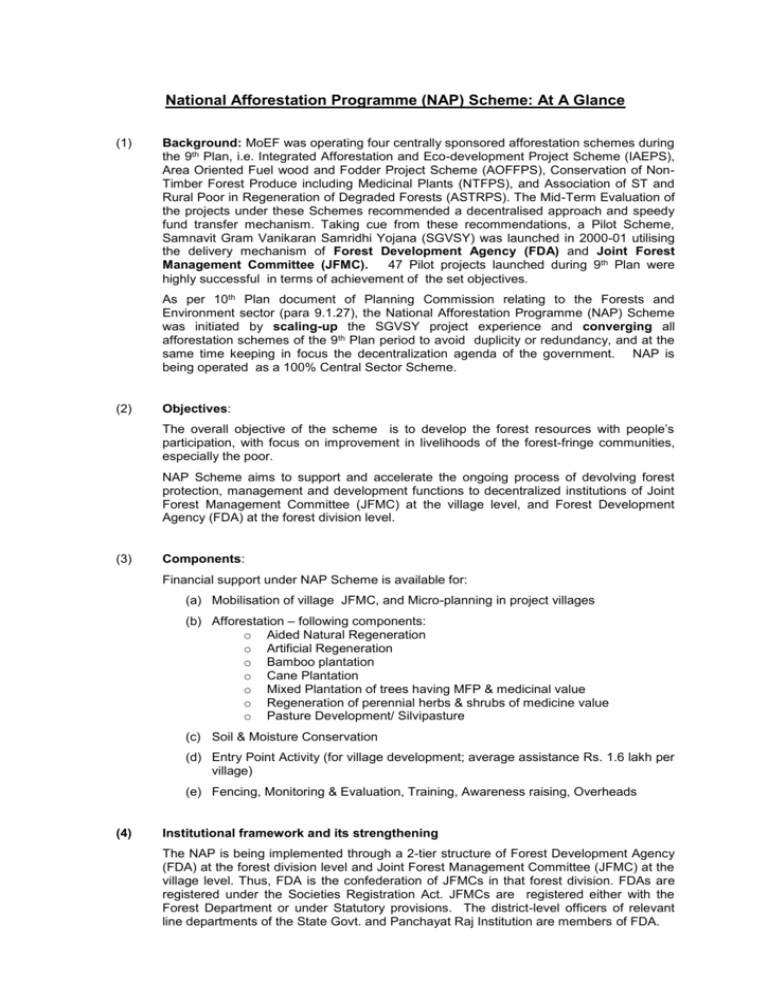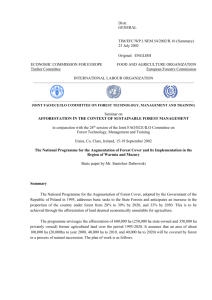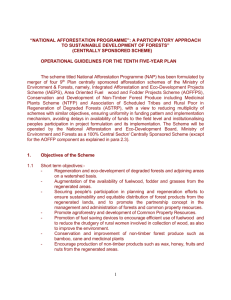National Afforestation Programme (NAP)
advertisement

National Afforestation Programme (NAP) Scheme: At A Glance (1) Background: MoEF was operating four centrally sponsored afforestation schemes during the 9th Plan, i.e. Integrated Afforestation and Eco-development Project Scheme (IAEPS), Area Oriented Fuel wood and Fodder Project Scheme (AOFFPS), Conservation of NonTimber Forest Produce including Medicinal Plants (NTFPS), and Association of ST and Rural Poor in Regeneration of Degraded Forests (ASTRPS). The Mid-Term Evaluation of the projects under these Schemes recommended a decentralised approach and speedy fund transfer mechanism. Taking cue from these recommendations, a Pilot Scheme, Samnavit Gram Vanikaran Samridhi Yojana (SGVSY) was launched in 2000-01 utilising the delivery mechanism of Forest Development Agency (FDA) and Joint Forest Management Committee (JFMC). 47 Pilot projects launched during 9th Plan were highly successful in terms of achievement of the set objectives. As per 10th Plan document of Planning Commission relating to the Forests and Environment sector (para 9.1.27), the National Afforestation Programme (NAP) Scheme was initiated by scaling-up the SGVSY project experience and converging all afforestation schemes of the 9th Plan period to avoid duplicity or redundancy, and at the same time keeping in focus the decentralization agenda of the government. NAP is being operated as a 100% Central Sector Scheme. (2) Objectives: The overall objective of the scheme is to develop the forest resources with people’s participation, with focus on improvement in livelihoods of the forest-fringe communities, especially the poor. NAP Scheme aims to support and accelerate the ongoing process of devolving forest protection, management and development functions to decentralized institutions of Joint Forest Management Committee (JFMC) at the village level, and Forest Development Agency (FDA) at the forest division level. (3) Components: Financial support under NAP Scheme is available for: (a) Mobilisation of village JFMC, and Micro-planning in project villages (b) Afforestation – following components: o Aided Natural Regeneration o Artificial Regeneration o Bamboo plantation o Cane Plantation o Mixed Plantation of trees having MFP & medicinal value o Regeneration of perennial herbs & shrubs of medicine value o Pasture Development/ Silvipasture (c) Soil & Moisture Conservation (d) Entry Point Activity (for village development; average assistance Rs. 1.6 lakh per village) (e) Fencing, Monitoring & Evaluation, Training, Awareness raising, Overheads (4) Institutional framework and its strengthening The NAP is being implemented through a 2-tier structure of Forest Development Agency (FDA) at the forest division level and Joint Forest Management Committee (JFMC) at the village level. Thus, FDA is the confederation of JFMCs in that forest division. FDAs are registered under the Societies Registration Act. JFMCs are registered either with the Forest Department or under Statutory provisions. The district-level officers of relevant line departments of the State Govt. and Panchayat Raj Institution are members of FDA. The recent experience with present institutional framework of FDA at the forest division level and JFMC at the village level is encouraging. All 28 States have adopted this institutional framework including in the Autonomous Hill Districts in Assam, Meghalaya and Mizoram. The institutions of FDAs and JFMCs are highly innovative resource transfer mechanisms whereby the Govt of India channelises funds directly to the grass root level implementing agency for the afforestation activities. The structure of FDAs and JFMCs also caters to the gender concerns, whereby women membership to the extent of 50% has been made mandatory in these bodies. Members of Schedule Castes and Schedule Tribes are the focus group in JFMCs. Training of FDA and JFMC members is organized by State Forest Departments, as well as by the Regional Centres of National Afforestation and Eco-development Board (7 Regional Centres in the country). To help and guide the FDAs and JFMCs, there is also a National-level Steering Committee of NAP and another at State level called State-level Coordination committee chaired respectively by Secretary (Environment and Forests), Government of India, and Chief Secretary of the State Government. The following additional steps are being undertaken to further strengthen these institutions:(a) A Training Needs Assessment exercise is being undertaken by the Regional Centres of National Afforestation and Eco-development Board to identify the needs and capacities of different categories of staff and members of JFMCs and FDAs for efficient implementation of NAP, and subsequently develop training modules for the same. (b) It is proposed to encourage linkage of JFMCs with other rural development programme. JFMCs may leverage outside funds to augment Entry Point Activity component of NAP for this purpose. (c) It is also proposed to formulate a financial management manual for FDAs and JFMCs so as to strengthen account keeping at the local level, and thus, empower communities for local-level decision making. (d) A national level JFM study has also been launched to assess strengths and weaknesses of implementation of JFM, and the progress of empowerment of the local communities in decision-making. (e) Establish a system of e-governance in National Afforestation and Ecodevelopment Board. (5) Monitoring and evaluation mechanism (a) With a view to increasing the efficiency of NAP to meet the above goals, the monitoring and evaluation (M&E) exercise of the FDA projects is undertaken both by the State and Central Governments. (b) National Afforestation and Eco-development Board undertakes the first independent mid-term evaluation of the FDA projects within 24 months of sanction of the project with focus on people’s participation, functioning of JFMCs/ EDCs and the micro-planning exercise. (c) The final evaluation is required to be carried in the fourth year of the Project. (d) So far, National Afforestation and Eco-development Board has launched midterm evaluation in respect of 250 FDA projects (including 47 Projects under SGVSY Scheme of the IX Plan). (e) In addition, the Forest Survey of India (FSI) has randomly selected 60 FDAs each in 2003-04, 2004-05 and 2005-06 for monitoring of area coverage and forest cover increase therein. (6) Activities undertaken so far 715 FDAs have been operationalised so far at a cost of Rs. 1,514.79 Crores to treat a total area of 9.23 lakh ha. (as on 31.3.2006). Bamboo plantation, medicinal plants and Jatropha have been given adequate focus under NAP during the current plan period. State Governments have been advised to earmark 10% of the project area under NAP, as per feasibility, for Jatropha plantation. Rehabilitation of jhumlands (shifting cultivation) have been given specific focus under the programme, and so far 19 jhum projects have been sanctioned in NE States and in Orissa. (7) Progress/ Achievement made during 2005-06 95 new FDA projects have also been sanctioned to cover an area of 55,232 hectare through 2,391 Joint Forest Management Committees (JFMCs). These include 12 new FDA projects in the North East to cover a total project area of 5380 ha. through 183 JFMCs. An amount of Rs. 248.58 Crores has been released to Forest Development Agencies during current financial year, out of which the release to North Eastern States is Rs. 45.80 Crores (up to 31.3.2006). (8) Physical Outputs and Expected Outcomes The goal of NAP is to promote improvement or increase in forest and tree cover. Two outcome parameters have, therefore, been identified with respect to NAP: (i) 5 years after sanction, new plantations would, for each bio-geographic region, show the prescribed survival rates. (ii) 6 to 12 years, after sanction, depending on the species, the new plantations would be revealed as either new area under Forest and Tree Cover or enrichment of forest cover in Satellite Imagery (9) Comparison of progress as compared to previous years Year-wise progress of National Afforestation Programme in the Tenth Five Year Plan is given in the table below. Year No. of JFMCs 2002-03 No. of new FDA projects operationalised 237 Project Area Release Crores) (Rs. 8209 405631 151.26 2003-04 231 7850 283272 207.98 2004-05 105 3474 107963 233.00 2005-06 (up to 31.3.2006) 95 2,391 55,232 248.58 (10) Sl. No. State-wise Status Progress of Forest Development Agency (FDA) projects from April, 2000 onwards (As on 31.3.2006) Name of State/Union No. of FDA Total project cost (in Area (in Territory Projects/Proposals Rs. crores) ha.) sanctioned 1 Andhra Pradesh 32 83.02 47400 2 Chhattisgarh 32 73.83 42514 3 Gujarat 21 60.87 30445 4 Haryana 18 53.44 22105 5 Himachal Pradesh 27 52.38 32378 6 Jammu & Kashmir** 31 74.61 47839 7 Karnataka 45 112.15 59180 8 Madhya Pradesh 49 112.48 76520 9 Maharashtra 45 98.62 65738 10 Orissa 40 69.65 55022 11 Punjab 9 17.65 8235 12 Rajasthan 33 39.22 28190 13 Tamil Nadu 32 93.60 52253 14 Uttar Pradesh 58 104.35 63004 15 Uttaranchal 37 54.17 39134 16 Goa 3 2.39 1250 17 Jharkhand 30 56.33 39850 18 Bihar 10 16.12 12315 19 Kerala 24 47.54 16250 20 West Bengal 17 39.07 22856 Total (Other States) 593 1261.49 762478 21 Arunachal Pradesh 19 27.04 21416 22 Assam 29 36.56 26955 23 Manipur 13 26.58 18374 24 Nagaland 16 37.71 25528 25 Sikkim 7 27.72 15280 26 Tripura 12 25.57 19405 27 Mizoram 19 60.12 26770 28 Meghalaya 7 12.00 7400 Total (NE States) 122 253.30 161128 TOTAL 715 1514.79 923606 (11) Budget Allocation of the Scheme and Progress of Expenditure Revised Estimate for the scheme during 2005-06 was Rs. 248.58 crores, out of which Rs. 248.58 crores were released till 31.3.06 (12) Implementing organization along with details The NAP Scheme is being implemented through two-tier decentralized mechanism of Forest Development Agency (FDA) at Forest Division Level and Joint Forest Management Committees (JFMCs) at the village level. (13) New initiatives under the scheme A number of initiatives have been taken by the Ministry to expedite the implementation of the scheme as well improve the qualitative aspects of implementation. These include: (i) in-principle decision has been taken by the National-level Steering Committee for electronic transfer the funds from Government of India to the FDAs to cut-down the delays, (ii) efforts are being made to step-up monitoring and evaluation of the FDA projects by activation of State-level Coordination Committees for NAP, increased field visit by officers, and expeditious commissioning by the States of first independent concurrent evaluation of FDA projects, (iii) 10 programmes have been arranged through the Directorate of Forest Education for training and capacity building of front-line staff of FDAs and JFMCs, and (iv) 45 district-level inter-departmental linkage workshops have been approved in the work programme of the Regional Centres of NAEB for the year 2005-06 and 2006-07 for promoting the linkage of NAP with other developmental programmes for enhancing the sustainability of JFM, and (v) a new component has been added in NAP to universalize JFM in all forest-fringe villages in the country. ***








